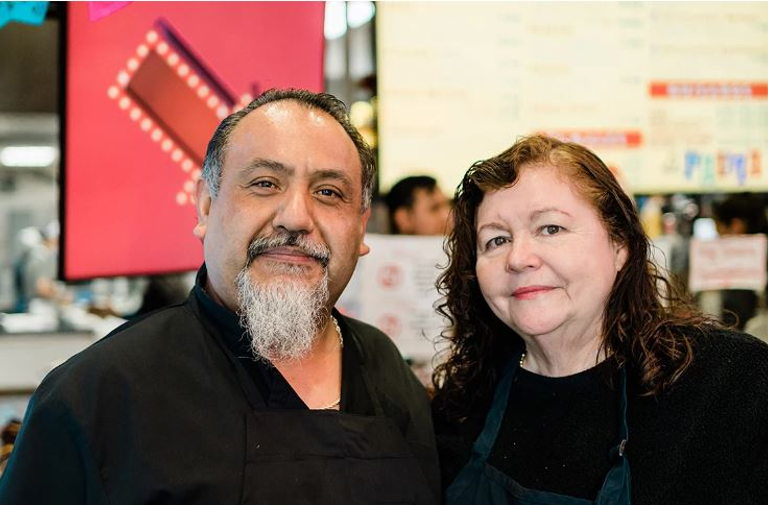For many immigrants, the first place they feel at home in the United States isn’t the place they live, but the place they buy the ingredients for their first home-cooked meal. The grocery store—the bodega, halal deli, spice shop, Asian fishmonger—has historically been not only where they reunite with the smells of their grandmother’s cooking or their favorite childhood street food, but also where they can hear a conversation in their mother language again, buy an herbal folk remedy, or catch up on local gossip. That shop can be the rare place in a new country where a migrant feels as though they are, at least within those four walls, part of a majority.
Public News Service · A Taste of Home: How Ethnic Grocery Stores Create Community
While the first ethnic grocery stores—food retailers catering to a migrant or diasporic culture—in the U.S. opened up during the 19th and early 20th centuries in urban minority neighborhoods in major cities, today, such grocery stores have mushroomed around the country, wherever new migrant communities have sprung up. And often, the communities surrounding these businesses are growing more diverse and globalized, even as their storefronts serve as hubs of cultural tradition.
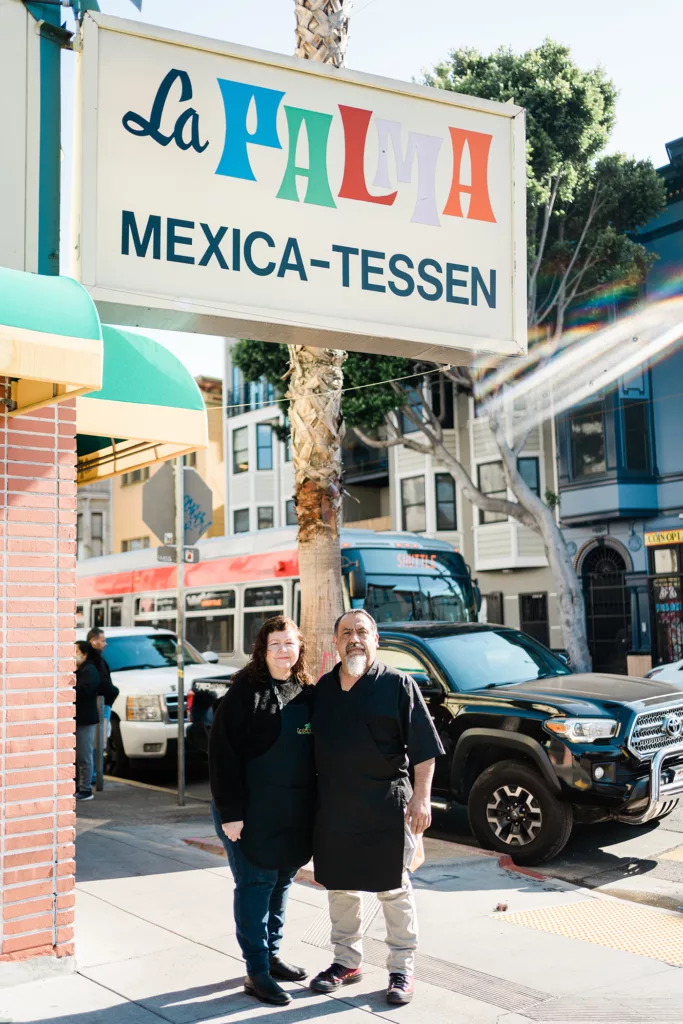
Aida Ibarra poses for a photo with her husband outside of La Palma Mexicatessen in the Mission District of San Francisco, California. Photo by Ed Carlo Garcia/YES! Media
An Authentic Experience
At La Palma, a “Mexicatessen” nestled in San Francisco’s historic Chicano neighborhood, the Mission District, generations of Latin American families have come for enchiladas and tamales that taste homemade for nearly 70 years. The current co-owner, Aida Ibarra, purchased it with family members in 1983 after working for years in the hospitality industry.
The work of managing a specialty kitchen and catering and wholesale operation that supplies local restaurants, with just a handful of employees, is grueling. When the city was largely shuttered during the height of the COVID-19 pandemic, Ibarra recalled how she felt an obligation to keep the store open, even though their business had suffered as the restaurants they usually supplied had closed. To limit the number of shoppers inside the store, customers had to line up outside, which frustrated some, but in the end, she recalled, “a lot of our customers thanked us for staying open. I guess they knew that it was a risk for us, too.”
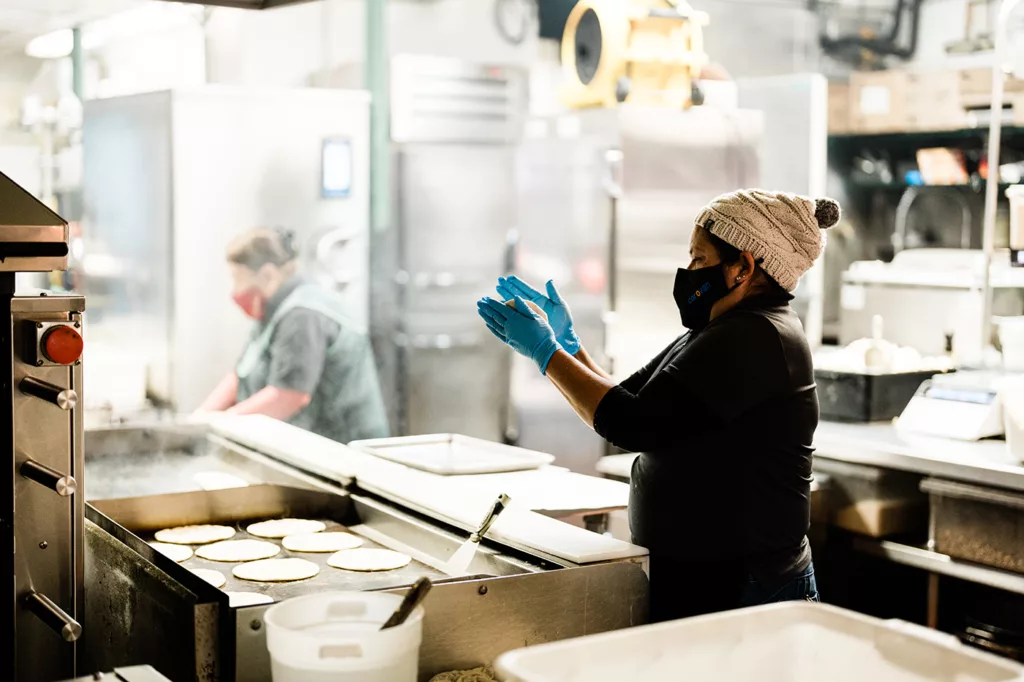
Photo by Ed Carlo Garcia/YES! Media
Although La Palma’s retail offerings are not as unique as when it was one of the city’s only Latino-owned businesses in the 1950s, Ibarra says it’s still the best spot in town to buy handmade tortillas, completely sourced in-house, right down to the corn kernels they painstakingly grind into masa. Compared with mass-produced tortillas from the supermarket, the taste is “a world of difference.”
“I think you have to experience, one time in your lifetime, a handmade tortilla or a handmade huarache,” she says. “Just because you don’t know what you’re missing, you really don’t, until you try it. … Ask them to give it to you from the grill.”
A Cultural Epiphany
In a Twin Cities suburb, the aromas of roasted lechon belly and fried fish cut through the frigid Minnesota winter air, comforting local Filipino immigrants, for whom Watson Fong founded his 2,000-square-foot grocery store several years ago. Asian Mart draws Filipinos from as far as South Dakota and other neighboring states, because, unlike coastal cities, the Midwest has few grocery stores that specialize in Pinoy items, like pancit noodles, banana ketchup, and ube ice cream.
Asian Mart is also a gathering spot for Twin Cities Filipinos, many of whom work in local health care facilities; Fong says it’s not unusual for friends to bump into each other after years of separation. The store has also been a local hub for the Philippines’ remittance economy by serving as a shipping point for boxes of American goods gifted to loved ones at home.
Besides offering nostalgic items, like longganisa sausage and shampoo powder, Fong tries to provide a homey ambiance for Filipinos in an unfamiliar landscape.
“We even play Filipino music so it feels like home, especially wintertime like this. We have snow. So, it’s really kind of very depressing compared to our weather, which is a very tropical climate,” he says, noting that for mixed Filipino and native-born American couples, “the Americans appreciate [us], because now they said their wives, their spouses, are not lonely now or homesick because of this store.”
Keeping up with the times, Asian Mart’s website takes online orders. But Fong thinks the brick-and-mortar store’s strength is the power of epiphany, when customers discover the things they did not know they were looking for. Customers might come in saying, “Oh, I just came here for a fish sauce,” he says, but leave with much more: “They can see a lot of things, the things that they can’t see from other stores. So they grab it.”
Culture as Comfort
Having grown up in a Vietnamese immigrant household, Maddie Nguyen felt a sense of familiarity in the Asian grocery stores she researched for her master’s thesis at the Yale School of Public Health. Although the owners were Chinese, she was surrounded by foods common to both cultures, like fish sauce, coagulated blood, and rice flour, sometimes sold loose with handwritten signs, like a classic street market. But, in addition to helping communities meet their practical needs, she found that the Asian grocers in New Haven, Connecticut, also created cultural safe spaces.
When browsing the stores, she felt “relaxed and comfortable being able to hear other people speak languages that weren’t English. Even though it was Chinese, and I don’t speak or understand Chinese. It was still comforting to hear that, because now I just felt safer, like, in my own skin. And that’s something that I don’t feel in the white American grocery stores.”
Nguyen’s auto-ethnographic research found that in addition to contributing to local cultural development, ethnic mom-and-pop shops can deeply enhance food security in working-class immigrant communities that otherwise have limited healthy food options. Public-health authorities should recognize the vital role ethnic grocery stores play in providing access to foods that are both nutritious and culturally relevant, she says,
“because nostalgia plays such an important role in our relationship with food. And if [consumers] are not invoking some sort of emotional reaction when it comes to food, why would we really want to invest in that? If it’s a food that we have no idea how to cook or use, or it doesn’t elicit some form of comfort or happiness, why would we choose that?”
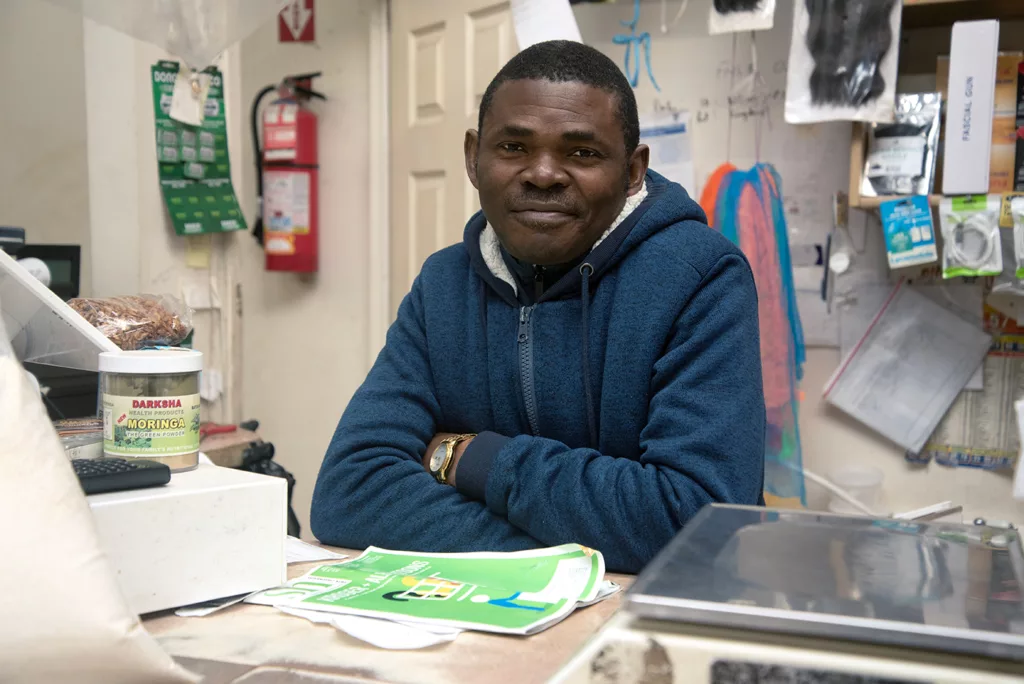
Moses Ufomba is the owner of Royal African and Caribbean Foods in the Bronx, New York. Photo by Ricky Day/YES! Media
Eating Like Their Ancestors
Moses Ufomba started Royal African and Caribbean Foods in the Bronx 17 years ago for immigrants who longed for yams and cassava in the land of potatoes. Part of his mission, Ufomba says, is to source natural ingredients for traditional African cookery that can be difficult to find in the U.S., such as ugba (fermented oil bean seeds), dried smoked fish, and imported frozen African vegetables.
Ufomba, who migrated from Nigeria to attend graduate school at Columbia University before starting his own business, sees his store as an opportunity to preserve ethnic foodways that are healthier than the typical American diet.
“The average diet of the African and African family is not sugar coated,” Ufomba says. “The average meal in America is [full of] sugar. … Sugar is a poison.” He believes that, in contrast to a place like New York City, the food and environment in Africa helps keep the body in balance, “because in Africa we sweat. You eat, you sweat, and you remove some toxins. But here, six months in the year, you’re not sweating, because it’s cold. And then you load your body with sugar. You’re killing yourself. So that’s why Africans want to eat their own food, the food they know.”
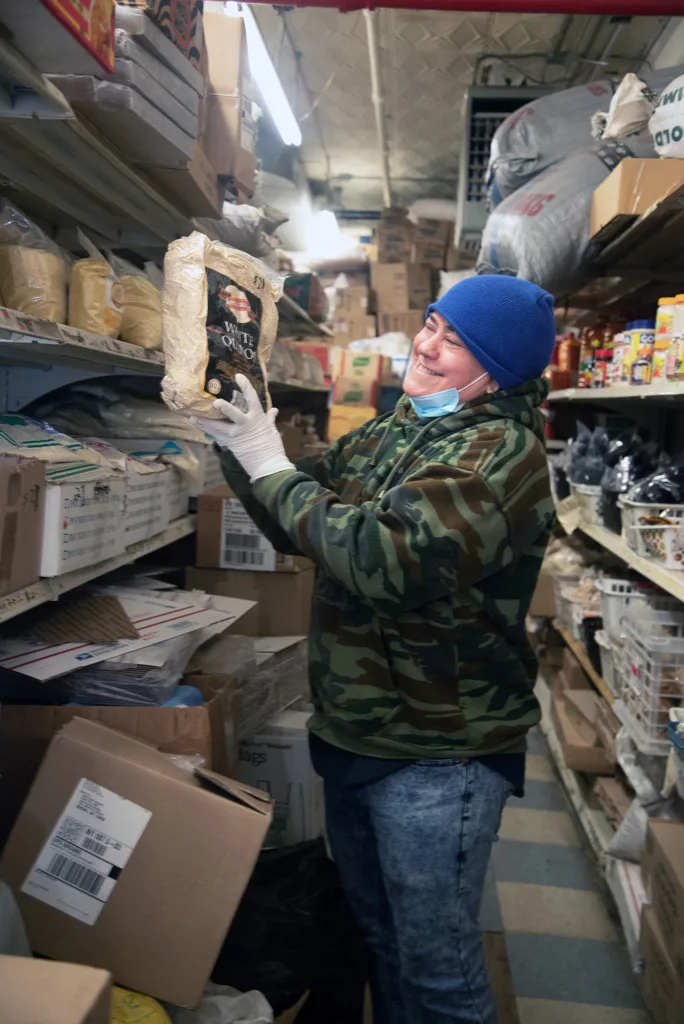
An employee restocking shelves. Photo by Ricky Day/YES! Media
Of course, Western influence still manifests in his inventory. Many items reflect the influences of colonization and globalization that link the peoples of the Caribbean and Africa, like Heinz Baked Beans, Nestlé milk drink powder, and instant ramen packets that have become a ubiquitous convenience meal across the Global South. And, with an inventory that encompasses multiple African and West Indian cuisines, and customers who also include white and Spanish-speaking people, he is not too much of a purist when it comes to serving the tastes of the diaspora.
“Any wise African that comes here must be open minded to learn, mix with people as much as possible, but not to give away your identity,” he says.
Safe Spaces
Every Ramadan, during Muslims’ month-long fast, Anas Dabbour helps his parents, immigrants from Syria, serve approximately 200 to 300 platters of chicken, rice, and other traditional homestyle foods daily, inviting everyone—fasting or not, regardless of religion—to an iftar at the Al-Aqsa Islamic Society in Philadelphia. The food is always free, sponsored by an anonymous donor.
“Just to be able to hand those platters out,” Dabbour says, “[to] see the happiness on the face of the people who are getting the food … we’re part of something much bigger than just people coming to eat, you know?”
The Al-Amana Grocery Store, which his parents have run for about two decades, is a cultural fulcrum within Al-Aqsa. Serving Middle Eastern staples, like kufta, shawarma, and falafel, the shop also provides meals to students at the Islamic Society’s school, the Aqsa Academy.
Dabbour began working at the store as a child, around the time his father enrolled him in the academy in order to keep him safe. After the Sept. 11, 2001, terrorist attacks, with anti-Muslim sentiment raging across the country, his parents decided to transfer him from the local public school to a place where his cultural identity would be embraced instead of shunned.
After school, he would stay in the store as his parents worked late, translating between English and Arabic for customers, bagging groceries, and discovering how gratifying it was to relieve his parents of even a little bit of the daily burden of running the business.
Dabbour still sees his role in the store as helping the Al-Aqsa community interface with the outside world. When he welcomes new customers, he says he is “able to explain to my neighbors, ‘Hey, our doors are open. We’re very friendly. [Ask] any questions you guys have, whether it’s about the store, the school, the religion, the Friday sermon, the call for prayer.’ … Sometimes, people will be like, ‘Oh, man, I heard this beautiful voice reciting something in Arabic. I have no clue what it is.’” For Dabbour, “just to have the opportunity to be able to speak about it … is a very, very wonderful thing.”
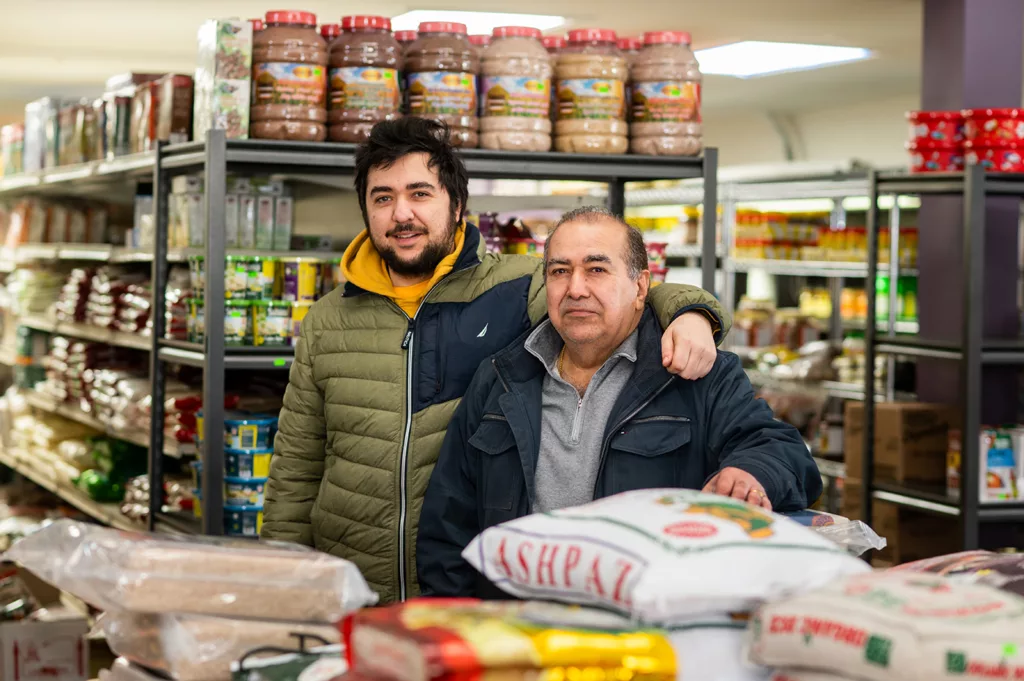
Raj Kumar Jawa poses for a photo with his son, Raj. Photo by Mitch Dao/YES! Media
Plant-Based, Before It Was Cool
Sometimes, a store stumbles upon a tradition that has become trendy again. India Sweets & Spices, one of California’s most established emporiums for South Asian snacks and sundries, began as a nondescript storefront in Culver City that Raj Kumar Jawa purchased in the early 1980s with money he had scraped together from doing odd jobs, like dishwashing and selling swimsuits on Venice Beach. Over the next 20 years, he launched a string of sister stores across California (and one branch in Oregon), catering to the region’s growing Asian immigrant communities.
Since Jawa started producing homemade hot foods, like samosas, to sell for “a dollar a dish” to desi university students, the store’s deli section has since become a go-to for local plant-based eaters, featuring a fulsome menu of dals, curries, chaats, dosas, and Indian sweets by the pound (plus, a more modern addition, the veggie burger). Jawa estimates that his eatery now attracts mostly non-South Asian customers.
“It used to be when you say vegetarian food, people say, ‘Ugh, vegetarian food—you’re feeding us grass,’ and they … go out and leave,” he recalls. “Now, that’s changed [in the] last 20 years. People are looking for vegetarian food. They are looking for vegan food. … They appreciate it.”
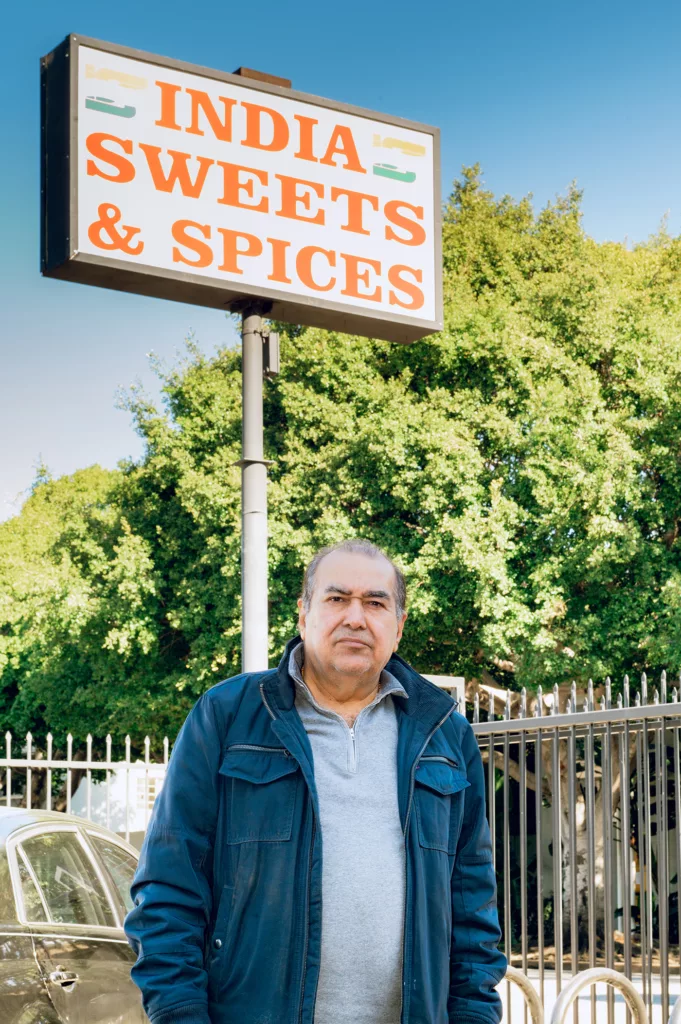
Raj Kumar Jawa poses for a photo in India Sweets & Spices in Culver City, California. Photo by Mitch Dao/YES! Media
The hot foods keep foot traffic coming through his doors even as e-commerce threatens to lure away customers who can buy a multitude of South Asian ingredients online.
“Amazon is hurting the small businesses and medium businesses right now because they have almost everything. You can order anything there,” he says. But he’s confident that people will always want to experience his store in person, so they can ask questions about the spices they’re buying, or simply sit down to a hot meal served by real people: “For a business like mine … people come to eat food. They don’t want to eat through Amazon.”
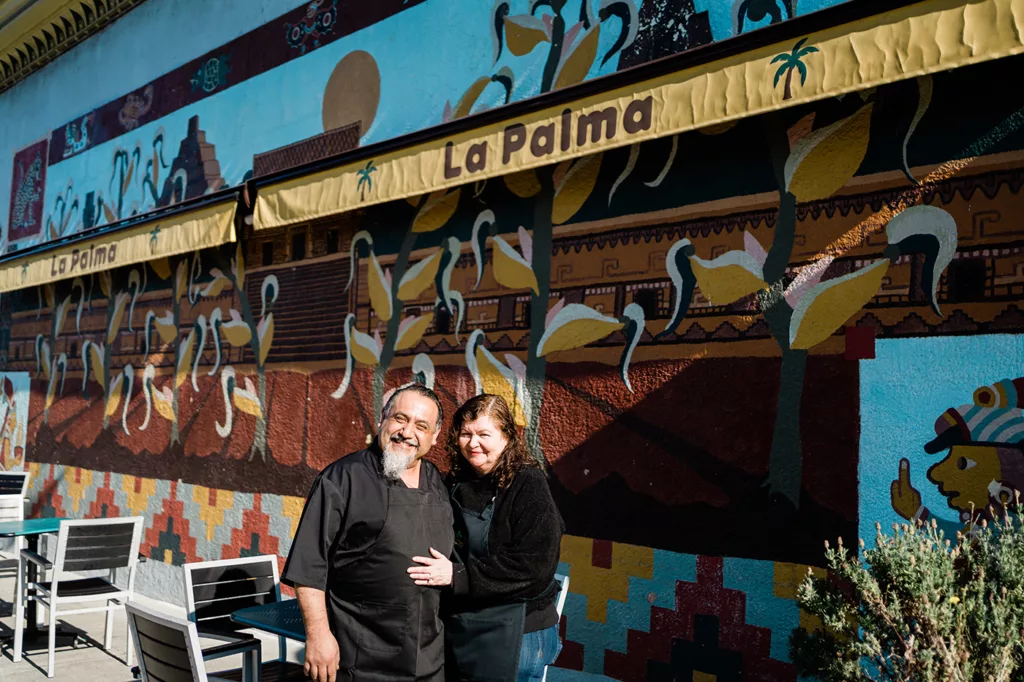
Aida Ibarra with her husband in front of La Palma Mexicatessen. Photo by Ed Carlo Garcia/YES! Media
The Future of the Ethnic Grocery Store
As much as the ethnic grocery store has historically served as a cultural pillar of immigrant communities, in many U.S. cities, the rising cost of living, competition from online food delivery services, and displacement of non-white neighborhoods through gentrification could undermine long-standing immigrant-run retail stores and markets.
These stores must also grapple with the question of succession. Overall, over half of private firms in the U.S. today (which are mostly small businesses) are run by people age 55 or older. Only a small percentage of these are passed down to family members; others may struggle to find a buyer or simply close down when the owners retire. Since their main aim in business was always earning a living rather than cultural preservation, owners of small ethnic groceries might be happy to see their children move onto a secure professional job, instead of the messy, exhausting work of running a store.
Ibarra has been thinking about the future of La Palma in a rapidly gentrifying San Francisco. Earning enough revenue to keep up with their fixed costs is “very hard, because the city requires a lot of rules … and the cost of living is so high. But then, if you look at a store like ours, we can only sell a burrito for so much, you know?” She worries about how “we have to work harder now and serve more people, so that we can make the wages that we need for the people.”
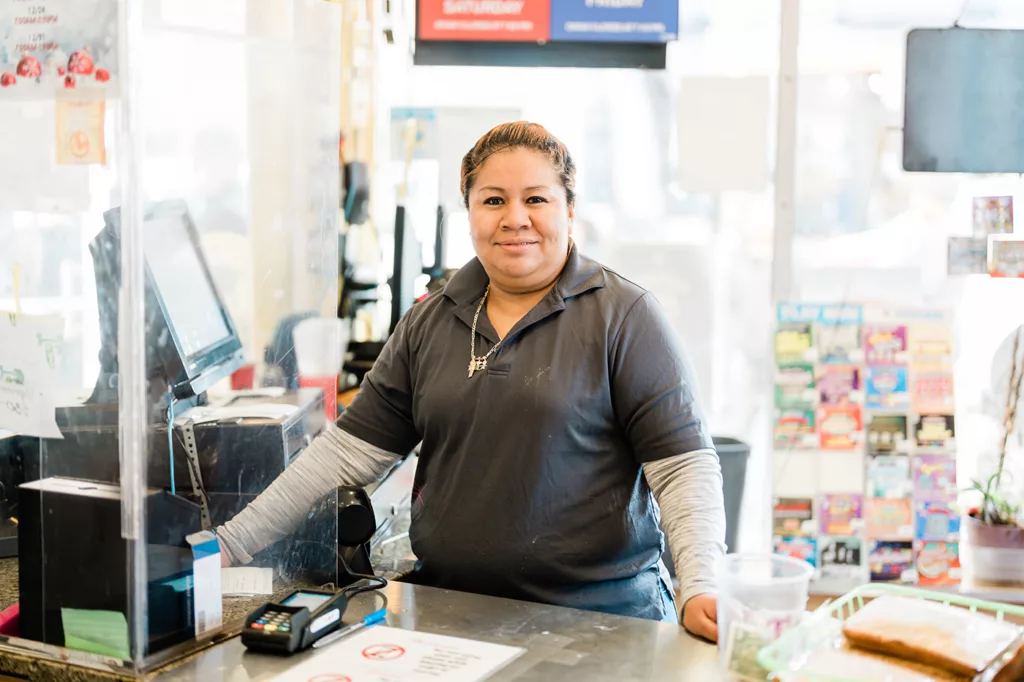
An employee at La Palma Mexicatessen. Photo by Ed Carlo Garcia/YES! Media
There are not many businesses of La Palma’s vintage left in the Mission. Ibarra fears what would happen to the community of loyal customers that it has built over the decades if it closes. But she is not sure who could take over the business; the day-to-day management of such an idiosyncratic, personal enterprise has consumed most of her life—15 years without a vacation—and it will be difficult to find a successor.
As for her children succeeding her, she says, “We told them, ‘You have to love this business to stay here. You have to really love it, and you have to learn every corner of it. Because when [the staff] call in and say they’re sick, you better know how to run that machine. You better know how to step in the kitchen.’”
For Dabbour, his family store’s kitchen seems to be his fate. He says his parents have always encouraged him to pursue his own career path, and he did go to community college to train in hospitality management and culinary arts, but he still gravitated back to the shop, helping to nourish a new generation of schoolchildren in the diaspora community that his parents helped create. He looks forward to his parents being able to retire comfortably at some point, though he is not sure when that will happen, because they remain so committed to the store. “Being in the food business for as long as we’ve been, it is something that comes to mind: Man, are we going to do this for the rest of our lives?” Nonetheless, he adds, the daily toil “keeps my parents young,” giving them a sense of spiritual purpose.
Dabbour believes he will eventually inherit Al-Amana, though he is wary of all the labor involved in running the store. “I have no problem with taking over the business,” he says, but asks himself, “Do I want to keep busting my butt for a few dollars?”
Still, he is driven to follow his parents’ path, shepherding the continuity of the community that raised him. “Seeing the people we interact with, seeing the little ones grow up to be young adults now, it is something that makes you feel like, you know what, it’s not really work. It’s more of a service.”
CORRECTION: This story was updated at 11:30 a.m. PT on Dec. 28, 2022 to note that several major cities, including those not on either coast, had immigrant-run grocery stores in the 19th century. Read our corrections policy.
This story is part of Building the Block, an original YES! series supported by a grant from the Center for Cultural Innovation’s AmbitioUS initiative, which encourages the development of burgeoning alternative economies and fresh social contracts in ways that can help artists and cultural communities achieve financial freedom. Reporting and production of this story was funded by this grant, but YES! maintains full editorial control of the content published herein. Read our editorial independence policy.


